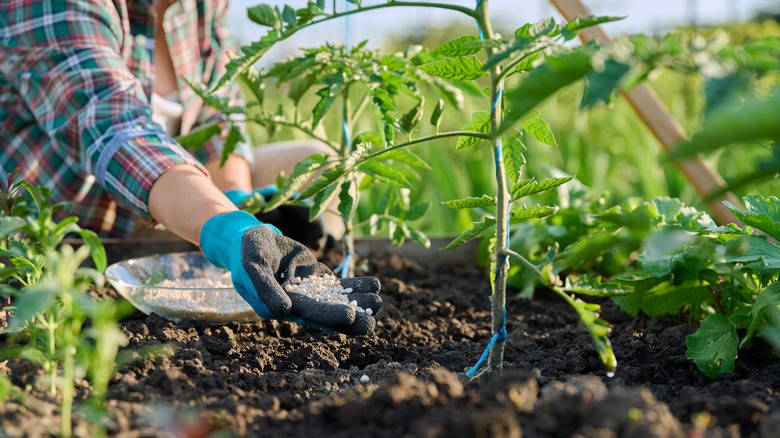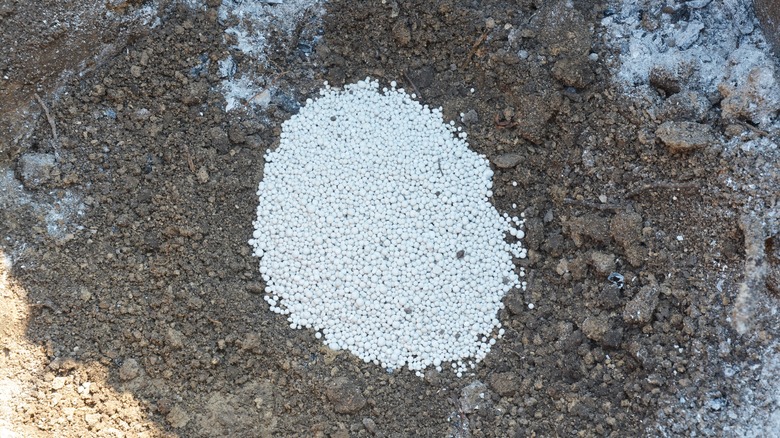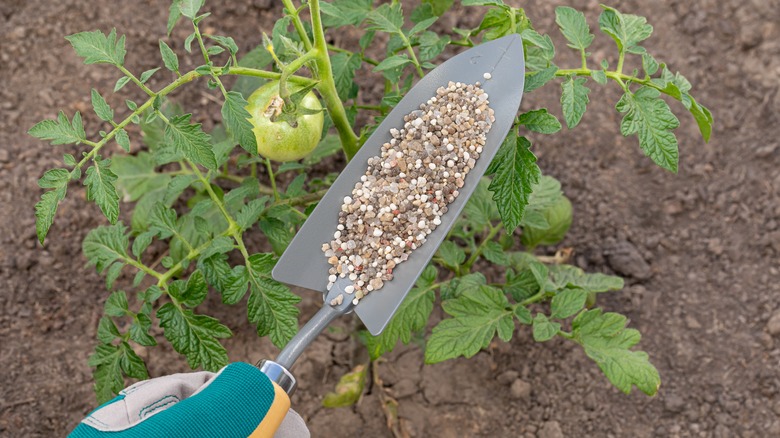How Often To Fertilize Tomato Plants Depending On Growth Stages
Fertilizing your garden can almost feel like a planting shortcut. Rather than having to wait to see results, you can feed your plants a healthy dose of super-nutrients and they'll begin to grow tall and bushy and drop fruits and vegetables. This is especially true with tomatoes, which love to gobble up the extra nutrients. "Tomatoes are fairly heavy feeders that do best with routine fertilizing throughout the growing season to support their large plant size and allow for ample fruit production," Deanna Talerico, a garden educator and creator of Homestead and Chill, exclusively tells House Digest. But that doesn't mean you should be pushing fertilizer on them all season long. Instead, you want to give it to the plant several times during the entire growing season: once right before you plant it, one more time when it starts developing fruit, and again a few weeks after.
By limiting your fertilization to these several times in a growing season, you ensure your plants get a safe amount of nutrition. It might seem counterintuitive, but too much fertilizer can actually have detrimental effects on your plants. For instance, adding too much when they're young can burn the plant, killing it off before you can harvest any ripe fruit. To avoid that, here is how often to fertilize your plants depending on growing stages.
Mix in fertilizer a week prior to planting
You want to give your seedlings the best possible start when planting them, and an easy way to do that is to place them into nutrient-rich soil. Because of that, the first time you should add fertilizer to your tomatoes is right before you plant them. This will prep the soil, making it as hospitable as possible for the young roots. "For the best results, amend the soil with compost along with a reputable, well-balanced, slow-release organic vegetable fertilizer (e.g., NPK 5-5-5) a week or two prior to planting," Talerico exclusively tells House Digest. When doing so, you want to limit the amount to what the packaging directions recommend, as well as avoid high-nitrogen varieties. These will "lead to large leafy growth but can inhibit the plant's ability to produce fruit," she explained.
As for what kind of compost to add, she recommends adding worm castings, crab meal, and mycorrhizae directly into the planting hole. "The worm castings offer additional slow-release nutrients, the mycorrhizae help increase rapid root development and nutrient uptake, and the crab meal adds a bit of extra calcium — which is essential for tomatoes and helps prevent blossom end rot," Talerico said. However, you want to avoid adding things like Epsom salt, which won't help prevent tomato blossom end rot. Instead, the salt will release magnesium sulfate, which will inhibit the plant from soaking in calcium, which is what it needs to prevent the rot.
Add fertilizer once more when it begins to fruit
The second time you want to add fertilizer is when you begin to notice fruit developing. This will help you grow the best tomatoes in your garden. However, adding it before they flower can actually slow rather than accelerate their growth. "Fertilizing too early or too often can produce large green growth but delay fruit production," Talerico told House Digest in an exclusive interview. You typically want to wait until the fruit is the size of a golf ball, and add about 1 tablespoon per plant. Be careful not to get any on their leaves as it can burn them.
Once your plants begin dropping fruit, you can begin to add fertilizer routinely to the ground, but you don't want to overdo it. "Once they begin fruiting, you can apply a well-balanced organic fertilizer every four to six weeks — such as by sprinkling a side dressing of slow-release granular fertilizer around the base of the plants and watering it in, or using gentle liquid fertilizer," Talerico explained. She also suggests watering the plant once with a homemade compost tea for your garden, which will help quickly deliver nutrients faster to the plant since it can soak them up via the roots. This is made by steeping your compost in water for several days, straining the solids, and using the nutrient-rich water.


